A Novel Synchronized Multiple Output DC-DC Converter Based on Hybrid Flyback-Cuk Topologies
Abstract
:1. Introduction
- The proposed HFC has only one switch with single primary isolated input and dual outputs.
- The voltage gain of HFC is enhanced by keeping it less than 1 for higher duty cycle values. Conventional flyback or Cuk converters experience a dramatic voltage gain increase after 50% duty cycles. Thus, HFC can be used for both step-up and step-down states.
- The switching losses for the switch are minimized. Hence, the efficiency of the proposed HFC is high and can reach around 90% for higher duty cycle values (e.g., 80% duty cycle).
- The proposed HFC can supply and receive energy simultaneously, making it suitable for different applications of energy conversion systems.
- An EV charger is used as a case study to demonstrate the efficacy of the proposed HFC. It can step down the voltage at high duty cycles, and simultaneous bidirectional operation was confirmed.
2. Analysis of the Proposed HFC Converter
- In steady-state, the average inductor voltage is zero.
- In steady-state, the average capacitor current is zero.
- In steady-state, the average value of the Cuk coupling capacitor (Ck) is Vin + Vo.
- A.
- When Q is ON: Both the flyback output diode (Df) and the Cuk diode (Dk) are reverse biased. Figure 3 illustrates the current and voltage directions for the ON state. During this period, the magnetization inductance (Lm) is being energized from the input voltage source. Therefore, the rate of change of current in the magnetization inductance is linearly increased according to the following equation:
- B.
- When Q is OFF: Diodes (Df) and (Dk) are conducting. Figure 4 shows the currents and voltage directions for the OFF state. During this mode, Lm is being de-energized by (−V1). The rate of change of current in the magnetization inductance is given by:
3. Simulation Results
3.1. Model Parameters
3.2. Results and Waveforms
3.3. Efficiency Assessment
3.4. Effect of Load Change
4. Application: Electric Vehicle Adapter
- 1.
- Forward the energy when Iin > 0 and Io_f > 0. This means the load consumed the power from the proposed converter’s upper terminals (flyback terminals).
- 2.
- Reverse the energy when Iin > 0 and Io_c < 0. This means the energy storage system is being charged from the proposed converter’s lower terminals (Cuk terminals).
5. Conclusions
Author Contributions
Funding
Data Availability Statement
Conflicts of Interest
References
- Bhaskar, M.S.; Padmanaban, S.; Almakhles, D.J.; Gupta, N.; Subramaniam, U. Double-switch switched-inductor converter with minimal switch voltage stress for renewable energy conversion. Comput. Electr. Eng. 2022, 98, 107682. [Google Scholar] [CrossRef]
- Obeidat, M.A.; Hamad, A. Applying Two Controller Schemes to Improve Input Tracking and Noise Reduction in DC-DC Converters. Przegląd Elektrotech. 2019, 95, 105. [Google Scholar] [CrossRef]
- Bottion, A.J.B.; Barbi, I. Input-Series and Output-Series Connected Modular Output Capacitor Full-Bridge PWM DC–DC Converter. IEEE Trans. Ind. Electron. 2015, 62, 6213–6221. [Google Scholar] [CrossRef]
- Marzang, V.; Tabbat, P.A.; Khoshkbar-Sadigh, A.; Mohseni, P.; Hashemzadeh, S.M.; Talebian, I. An Interleaved High Step-Up DC-DC Converter with Low Voltage-Stress on Semiconductors. In Proceedings of the IECON 2020 The 46th Annual Conference of the IEEE Industrial Electronics Society, Singapore, 18–21 October 2020; pp. 1223–1228. [Google Scholar] [CrossRef]
- Outeiro, M.T.; Visintini, R.; Buja, G. Considerations in Designing Power Supplies for Particle Accelerators. In Proceedings of the IECON 2013-39th Annual Conference of the IEEE Industrial Electronics Society, Vienna, Austria, 10–13 November 2013; pp. 7076–7081. [Google Scholar]
- Richelli, A.; Salem, M.; Colalongo, L. A Review of Fully Integrated and Embedded Power Converters for IoT. Energies 2021, 14, 5419. [Google Scholar] [CrossRef]
- Zhang, N.; Sutanto, D.; Muttaqi, K.M. A review of topologies of three-port DC-DC converters for the integration of renewable energy and energy storage system. Renew. Sustain. Energy Rev. 2016, 56, 388–401. [Google Scholar] [CrossRef]
- Kushwaha, R.; Singh, B. A Power Quality Improved EV Charger With Bridgeless Cuk Converter. IEEE Trans. Ind. Appl. 2019, 55, 5190–5203. [Google Scholar] [CrossRef]
- Pires, V.F.; Cordeiro, A.; Foito, D.; Silva, J.F. High Step-Up DC–DC Converter for Fuel Cell Vehicles Based on Merged Quadratic Boost–Ćuk. IEEE Trans. Veh. Technol. 2019, 68, 7521–7530. [Google Scholar] [CrossRef]
- Ananthapadmanabha, B.R.; Maurya, R.; Arya, S.R. Improved Power Quality Switched Inductor Cuk Converter for Battery Charging Applications. IEEE Trans. Power Electron. 2018, 33, 9412–9423. [Google Scholar] [CrossRef]
- Dong, H.; Xie, X.; Zhang, L. A New CCM/DCM Hybrid-Mode Synchronous Rectification Flyback Converter. IEEE Trans. Ind. Electron. 2020, 67, 3629–3639. [Google Scholar] [CrossRef]
- Pesce, C.; Blasco, R.; Riedemann, J.; Andrade, I.; Peña, R. A DC-DC Converter Based On Modified Flyback Converter Topology. IEEE Lat. Am. Trans. 2016, 14, 3949–3956. [Google Scholar] [CrossRef]
- Tamyurek, B.; Kirimer, B. An Interleaved High-Power Flyback Inverter for Photovoltaic Applications. IEEE Trans. Power Electron. 2015, 30, 3228–3241. [Google Scholar] [CrossRef]
- Marjani, J.; Imani, A.; Hekmati, A.; Afjei, E. A new dual output DC-DC converter based on SEPIC and Cuk converters. In Proceedings of the 2016 International Symposium on Power Electronics, Electrical Drives, Automation and Motion (SPEEDAM), Capri, Italy, 22–24 June 2016; pp. 946–950. [Google Scholar] [CrossRef]
- Banaei, M.R.; Hossein, A.; Alizadeh, R.; Farakhor, A. Non-isolated multi-input–single-output DC/DC converter for photovoltaic power generation systems. IET Power Electron. 2014, 7, 2806–2816. [Google Scholar] [CrossRef]
- Lodh, T.; Majumder, T. A high gain high-efficiency negative output flyback-Cuk integrated DC-DC converter. In Proceedings of the 2016 International Conference on Signal Processing, Communication, Power and Embedded System (SCOPES), Paralakhemundi, India, 3–5 October 2016; pp. 63–68. [Google Scholar] [CrossRef]
- Tseng, S.-Y.; Fan, J.-H. Buck-boost/flyback hybrid converter for solar power system applications. Electronics 2021, 10, 414. [Google Scholar] [CrossRef]
- Da Costa, A.E.L.; Andersen, R.L. In High-gain boost-boost-flyback converter for renewable energy sources applications. Proceeding of the 2015 IEEE 13th Brazilian Power Electronics Conference and 1st Southern Power Electronics Conference (COBEP/SPEC), Fortaleza, Brazil, 29 November 2015; pp. 1–6. [Google Scholar]
- Zhang, F.; Xie, Y.; Hu, Y.; Chen, G.; Wang, X. A hybrid boost–flyback/flyback microinverter for photovoltaic applications. IEEE Trans. Ind. Electron. 2019, 67, 308–318. [Google Scholar] [CrossRef]
- Shitole, A.B.; Sathyan, S.; Suryawanshi, H.; Talapur, G.G.; Chaturvedi, P. Soft-switched high voltage gain boost-integrated flyback converter interfaced single-phase grid-tied inverter for spv integration. IEEE Trans. Ind. Appl. 2017, 54, 482–493. [Google Scholar] [CrossRef]
- Alatai, S.; Salem, M.; Ishak, D.; Das, H.S.; Alhuyi Nazari, M.; Bughneda, A.; Kamarol, M. A Review on State-of-the-Art Power Converters: Bidirectional, Resonant, Multilevel Converters and Their Derivatives. Appl. Sci. 2021, 11, 10172. [Google Scholar] [CrossRef]
- Zhang, F.; Yan, Y. Novel Forward-Flyback Hybrid Bidirectional DC-DC Converter. IEEE Trans. Ind. Electron. 2009, 5, 1578–1584. [Google Scholar] [CrossRef]
- Chiu, H.-J.; Lo, Y.-K.; Lee, H.-C.; Cheng, S.-J.; Yan, Y.-C.; Lin, C.-Y.; Wang, T.-H.; Mou, S.C. A Single-Stage Soft- Switching Flyback Converter for Power-Factor-Correction Application. IEEE Trans. Ind. Electron. 2010, 57, 2187–2190. [Google Scholar] [CrossRef]
- Anand, A.; Singh, B. Modified Dual Output Cuk Converter-Fed Switched Reluctance Motor Drive with Power Factor Correction. IEEE Trans. Power Electron. 2019, 34, 1. [Google Scholar] [CrossRef]
- Mahafzah, K.; Krischan, K.; Muetze, A. Efficiency Enhancement of a Three Phase Hard Switching Inverter Under Light Load Conditions. In Proceedings of the IECON 2016, Florence, Italy, 23–26 October 2016. [Google Scholar]
- Orabi, M.; Shawky, A. Proposed Switching Losses Model for Integrated Point-of-Load Synchronous Buck Converters. IEEE Trans. Power Electron. 2015, 30, 9. [Google Scholar] [CrossRef]
- Glitz, E.S.; Ordonez, M. MOSFET Power Loss Estimation in LLC Resonant Converters: Time Interval Analysis. IEEE Trans. Power Electron. 2019, 34, 12. [Google Scholar] [CrossRef]
- Begwani, A.K.; Ustun, T.S. Electric bus migration in Bengaluru with dynamic charging technologies. AIMS Energy 2017, 5, 944–959. [Google Scholar] [CrossRef]
- Ustun, T.S.; Zayegh, A.; Ozansoy, C. Electric vehicle potential in Australia: Its impact on smartgrids. IEEE Ind. Electron. Mag. 2013, 7, 15–25. [Google Scholar] [CrossRef]
- Hussain, S.M.S.; Aftab, M.A.; Ali, I.; Ustun, T.S. IEC 61850 based energy management system using plug-in electric vehicles and distributed generators during emergencies. Int. J. Electr. Power Energy Syst. 2020, 119, 105873. [Google Scholar] [CrossRef]
- Ustun, T.S.; Hussain, S.M.S.; Syed, M.H.; Dambrauskas, P. IEC-61850-Based Communication for Integrated EV Management in Power Systems with Renewable Penetration. Energies 2021, 14, 2493. [Google Scholar] [CrossRef]
- Aftab, M.A.; Hussain, S.M.S.; Ali, I.; Ustun, T.S. IEC 61850 and XMPP Communication Based Energy Management in Microgrids Considering Electric Vehicles. IEEE Access 2018, 6, 35657–35668. [Google Scholar] [CrossRef]
- Ustun, T.S.; Hussain, S.M.S.; Kikusato, H. IEC 61850-Based Communication Modeling of EV Charge-Discharge Management for Maximum PV Generation. IEEE Access 2019, 7, 4219–4231. [Google Scholar] [CrossRef]
- Chakraborty, S.; Vu, H.-N.; Hasan, M.M.; Tran, D.-D.; Baghdadi, M.E.; Hegazy, O. Dc-dc converter topologies for electric vehicles, plug-in hybrid electric vehicles and fast charging stations: State of the art and future trends. Energies 2019, 12, 1569. [Google Scholar] [CrossRef]
- Pellitteri, F.; Di Dio, V.; Puccio, C.; Miceli, R. A model of dc-dc converter with switched-capacitor structure for electric vehicle applications. Energies 2022, 15, 1224. [Google Scholar] [CrossRef]
- Heydari-doostabad, H.; O’Donnell, T. A wide-range high-voltage-gain bidirectional dc–dc converter for v2g and g2v hybrid ev charger. IEEE Trans. Ind. Electron. 2021, 69, 4718–4729. [Google Scholar] [CrossRef]
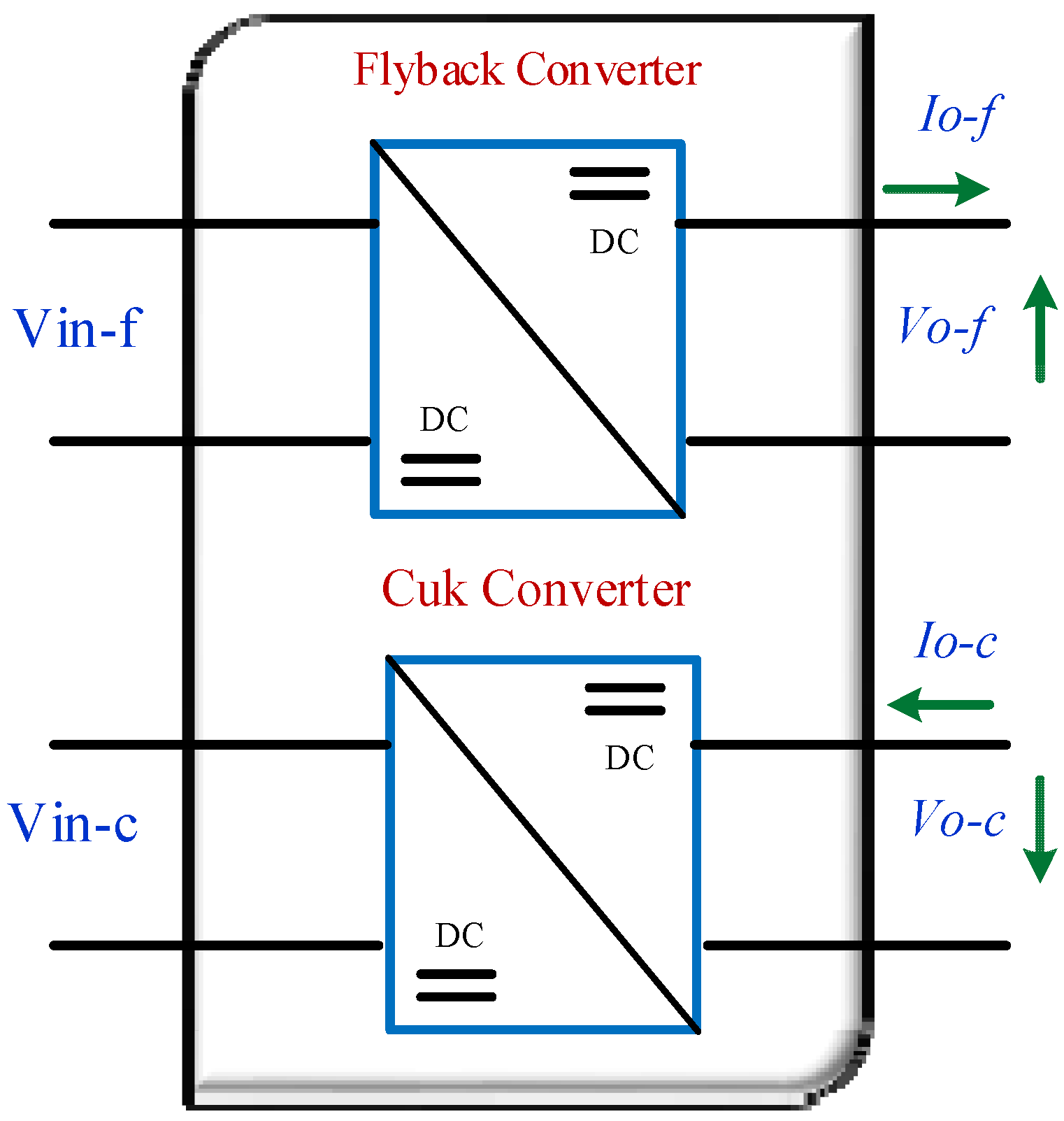
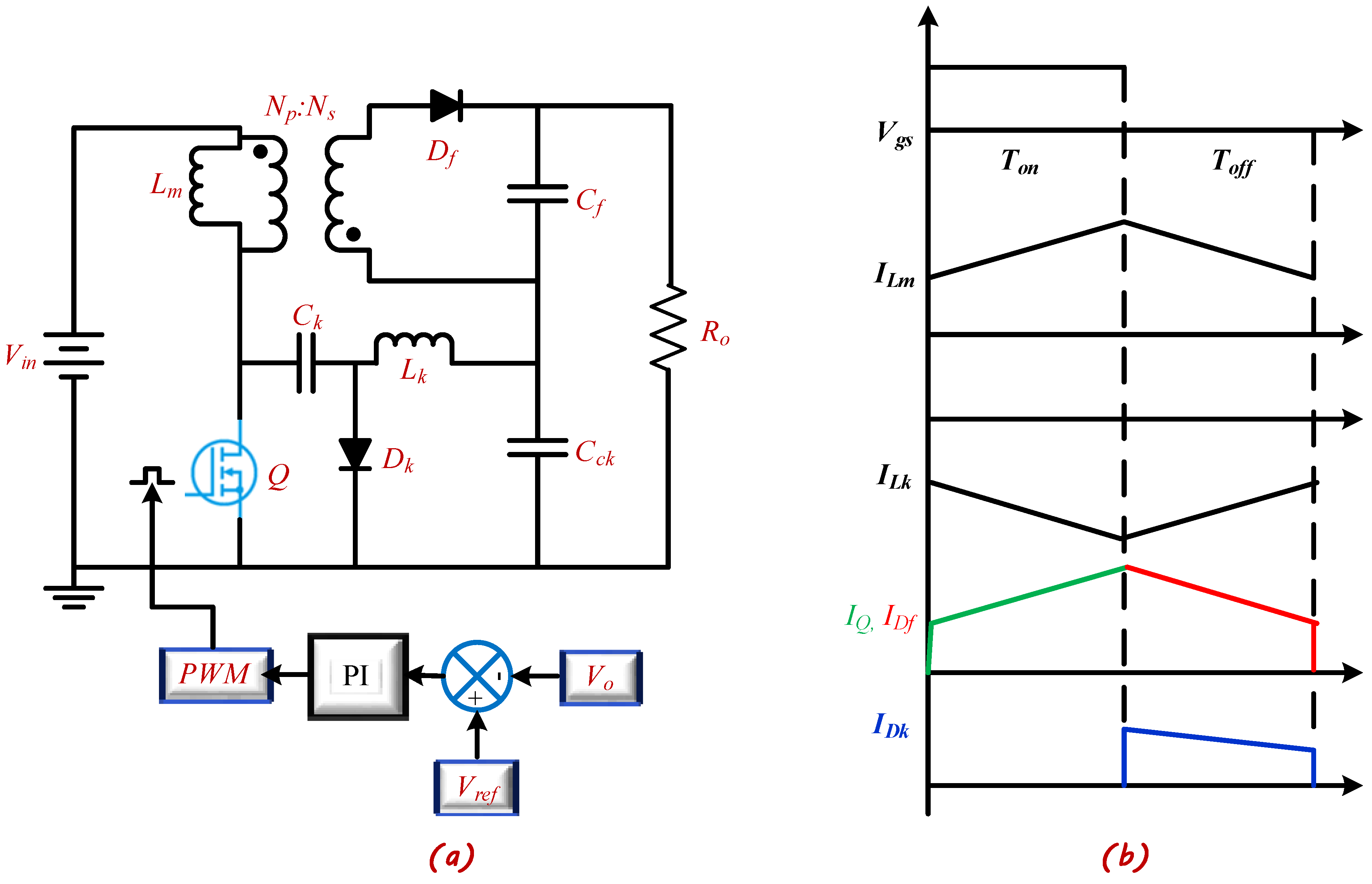

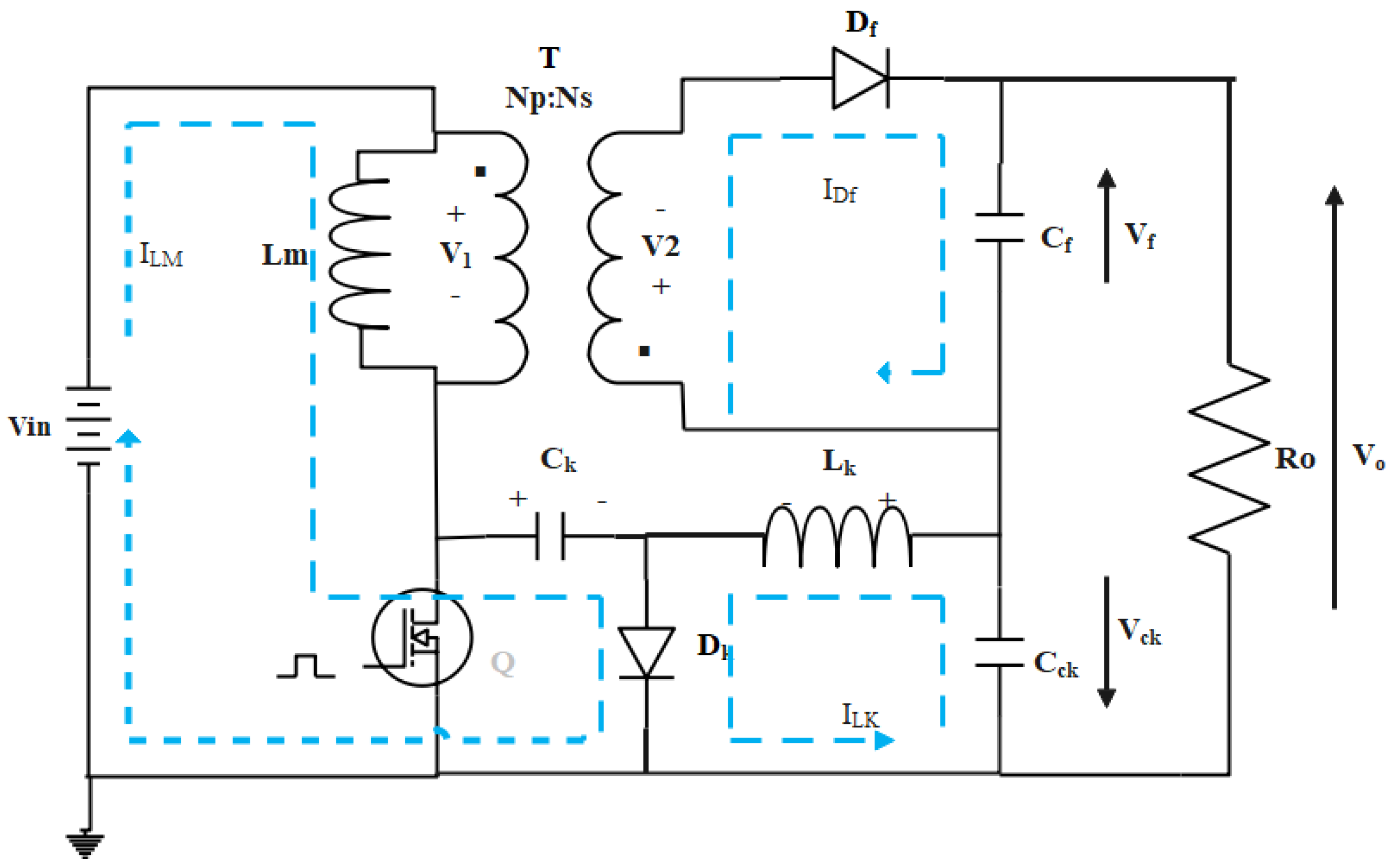
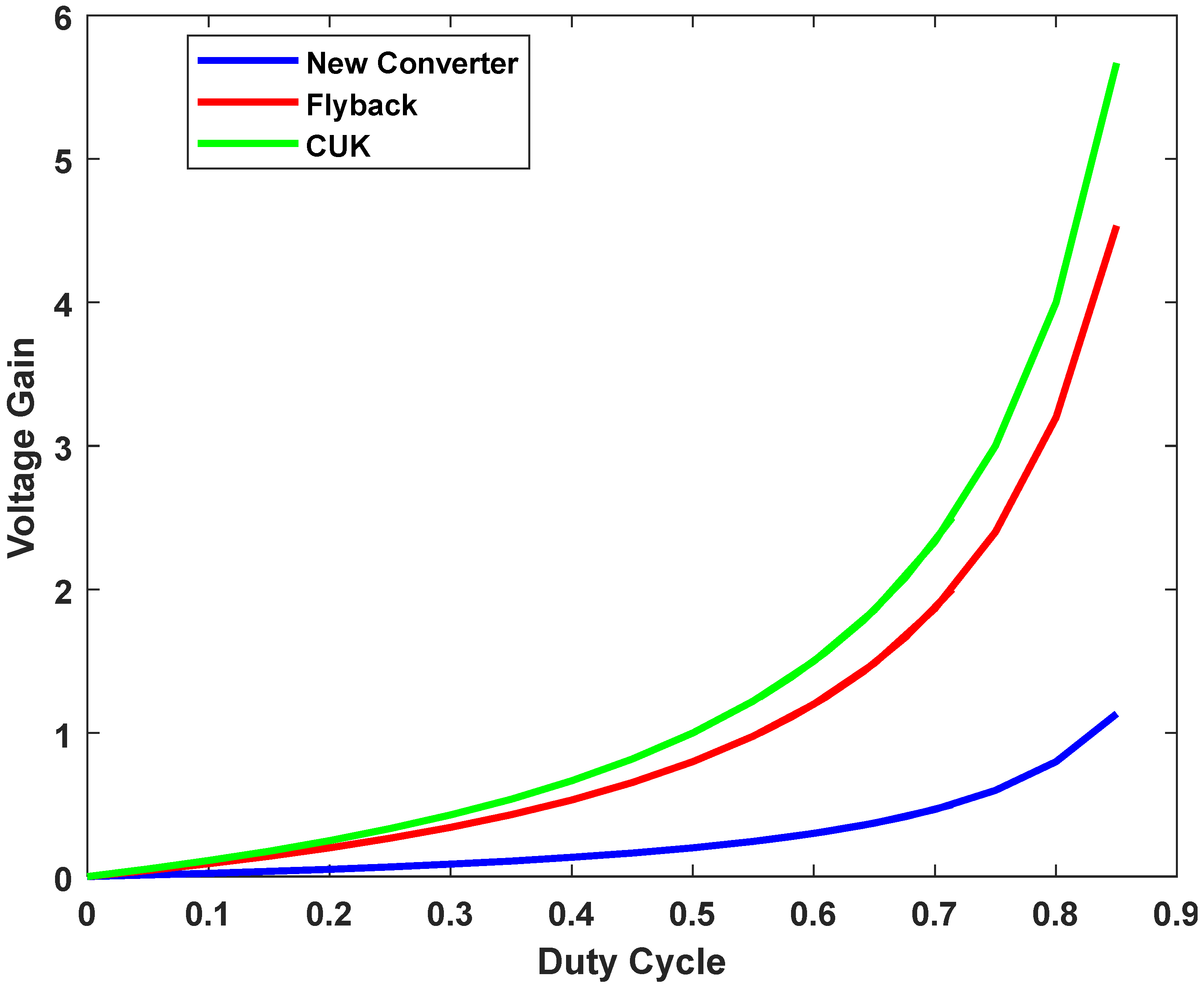
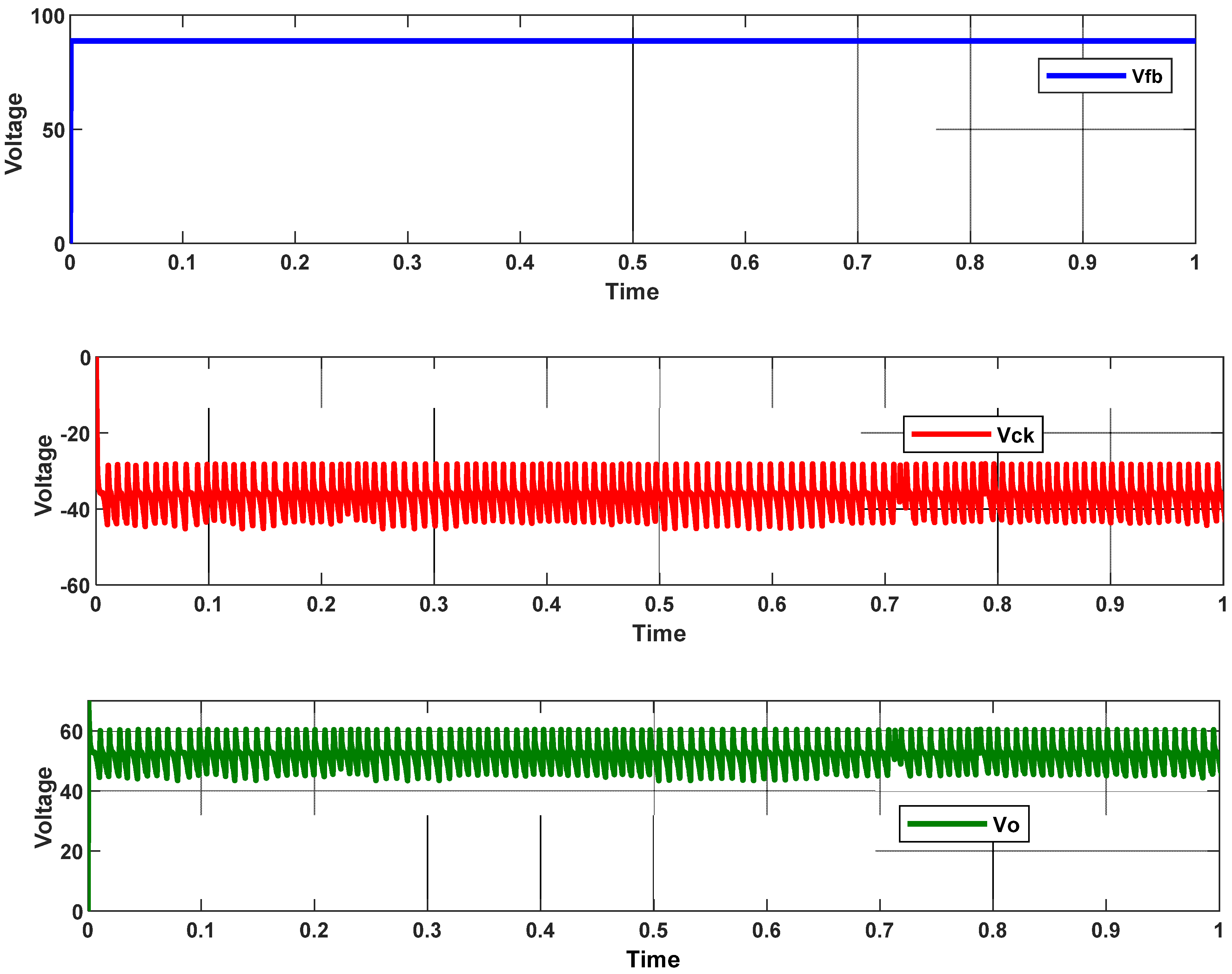


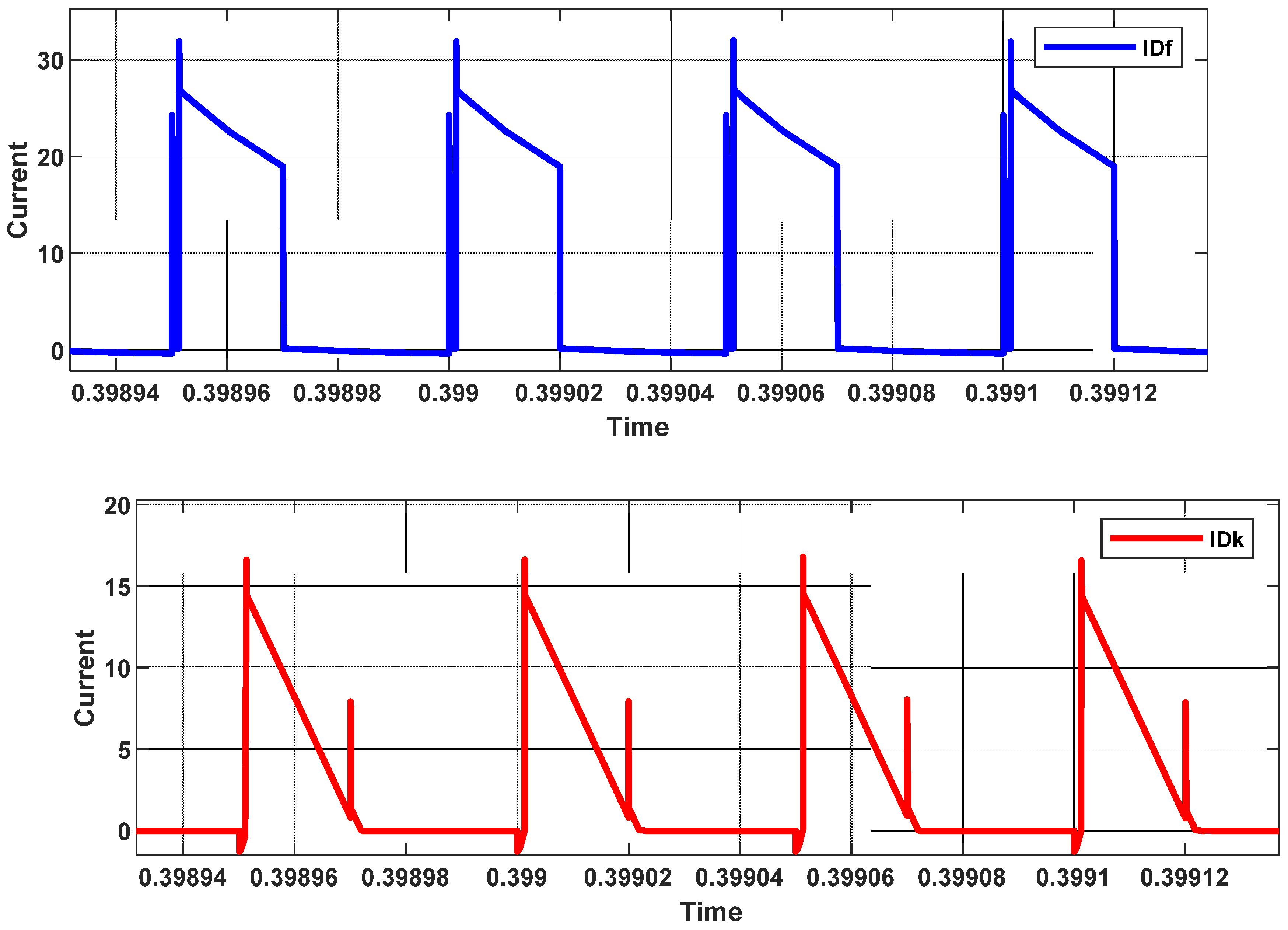

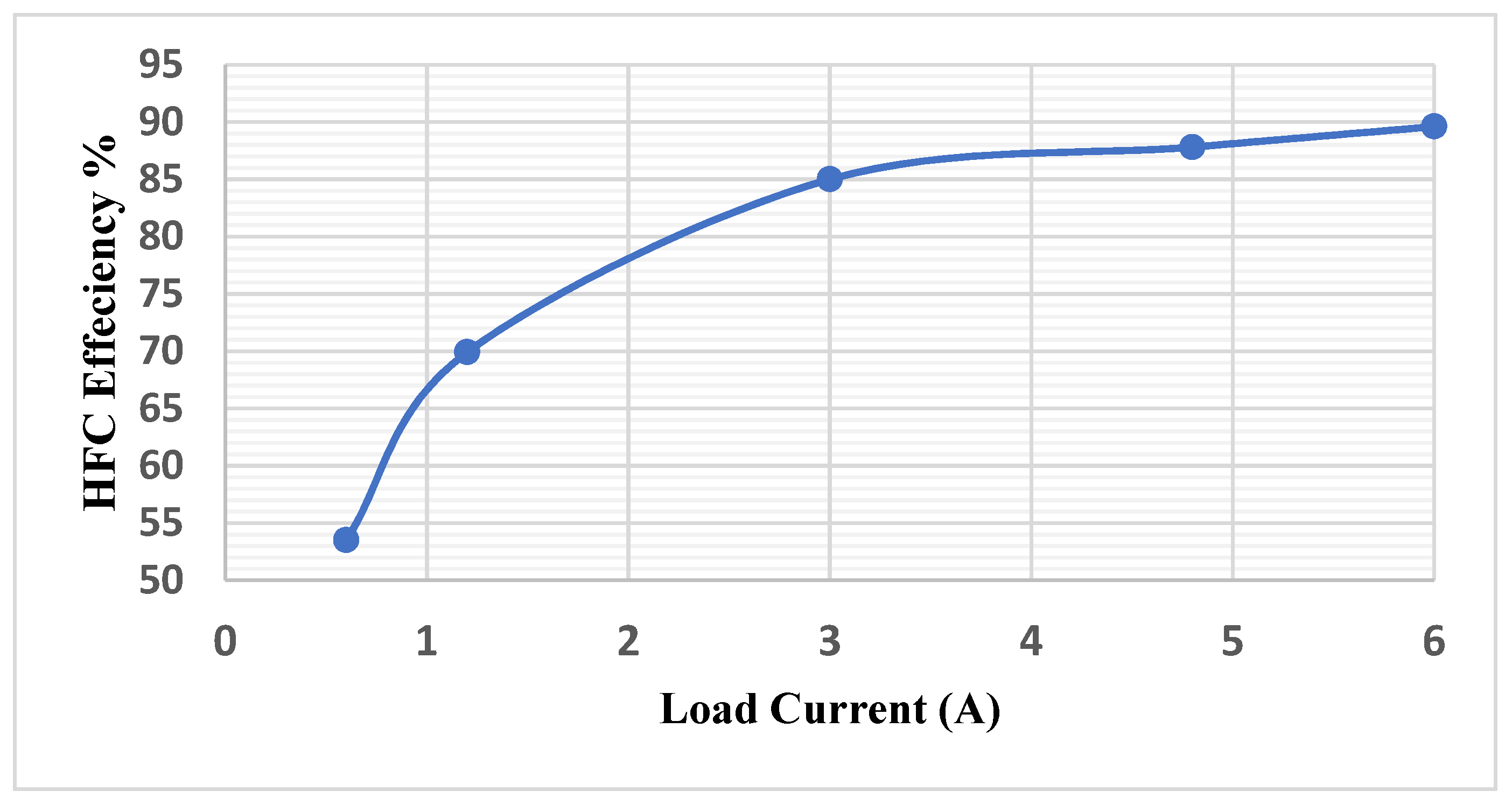



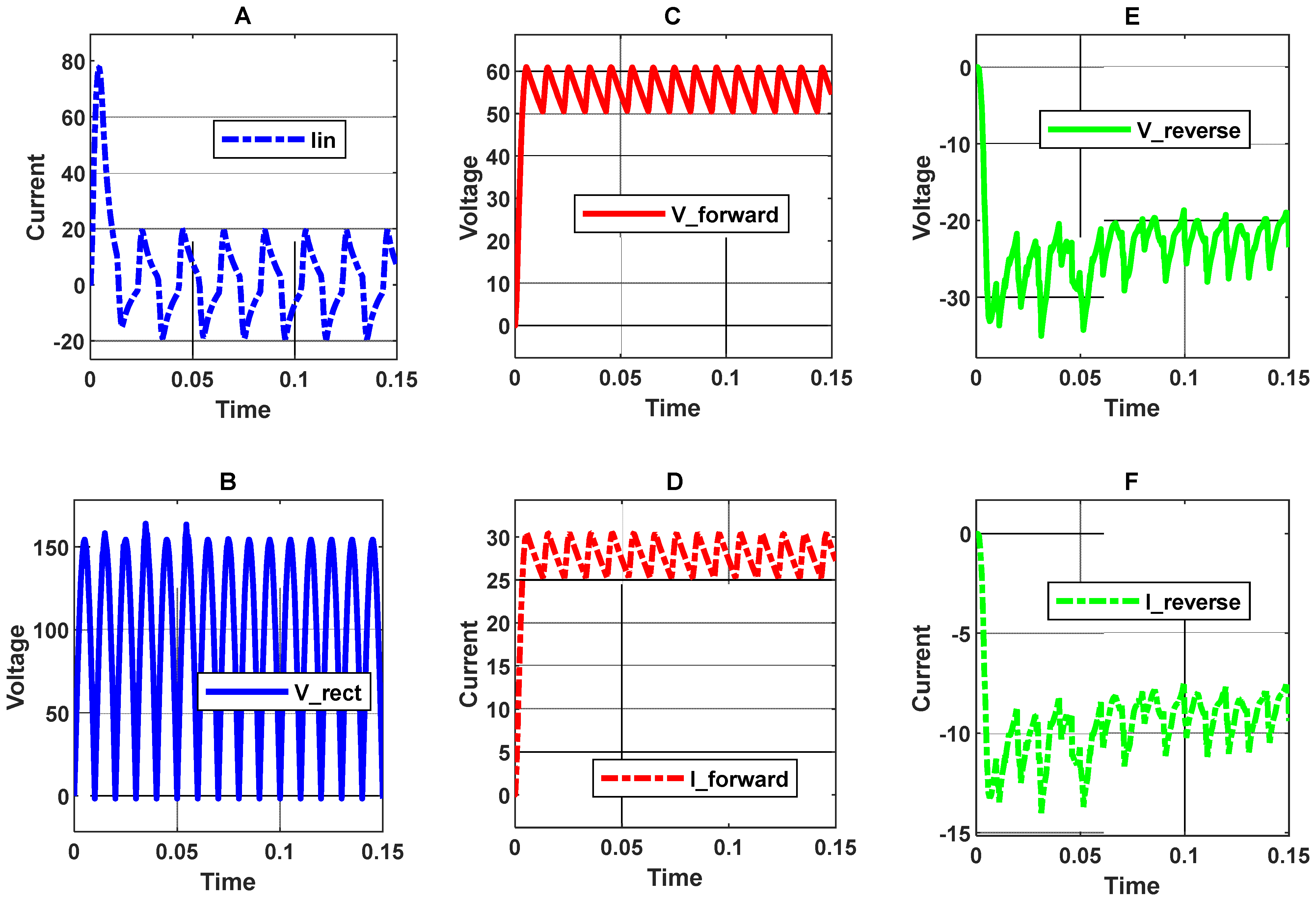
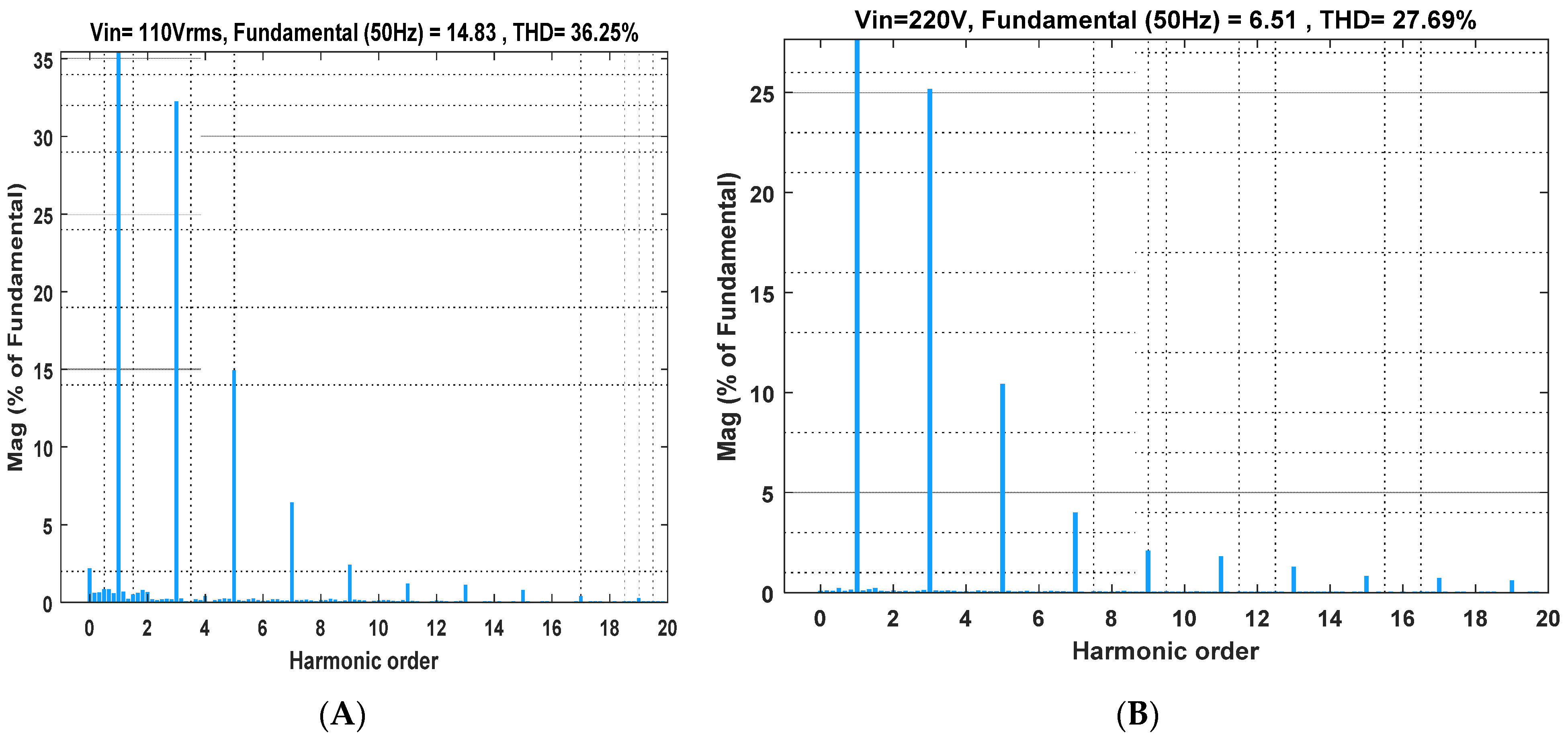
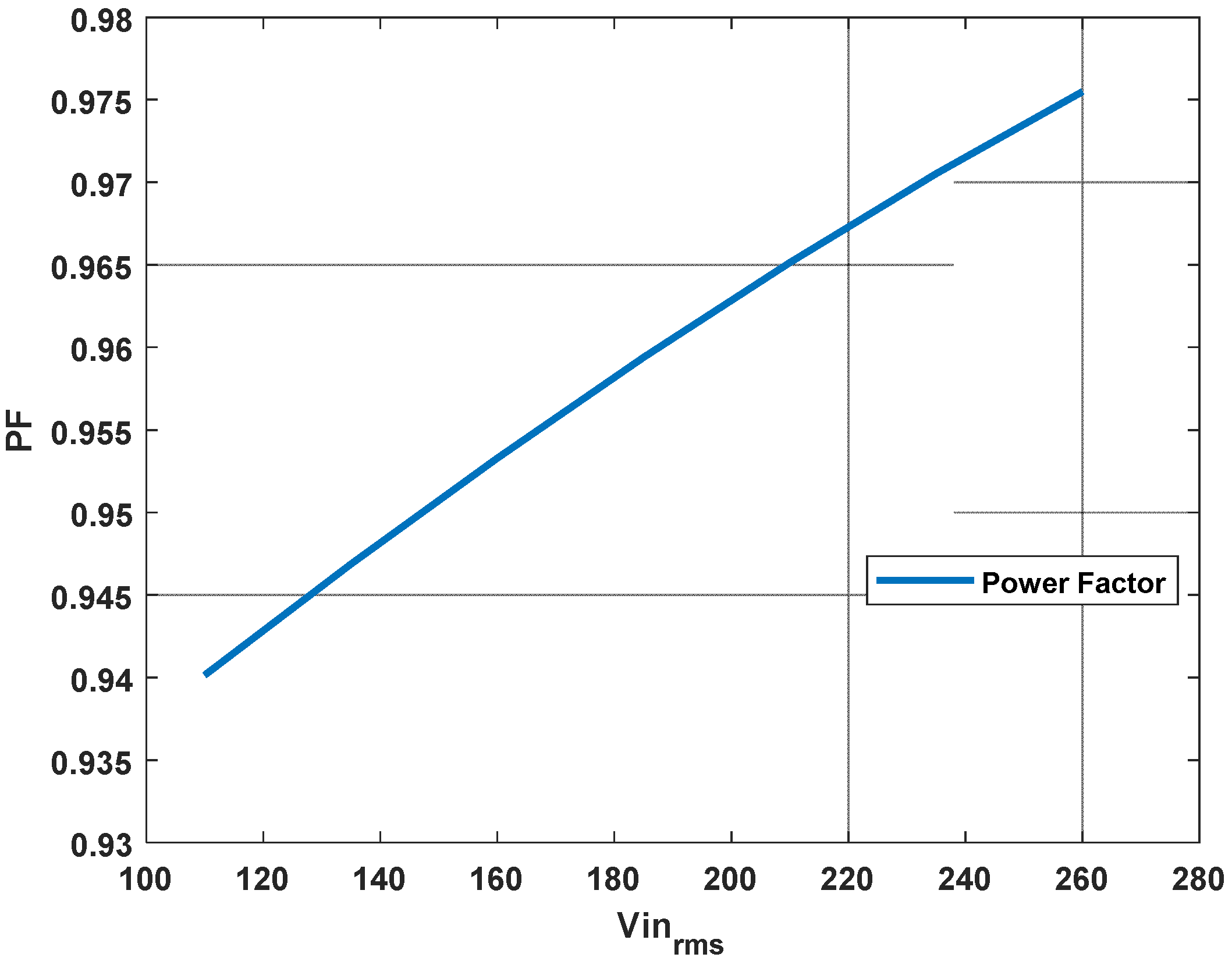
| Parameter | Description | Value |
|---|---|---|
| Pin/Po | input/output power | 300 W |
| Vin | input voltage | 220 V |
| Vo | output voltage | 50 V |
| Io | output current | 6 A |
| Ro | load resistance | 8.3 Ω |
| fs | switching frequency | 20 kHz |
| Lm | magnetization inductance | 18 mH |
| Np/Ns | transformer T turns ratio | 220/90 |
| Cf | flyback output capacitance | 0.2 mF |
| Ck | Cuk coupling capacitance | 110 uF |
| Lk | Cuk second inductance | 34 uH |
| Cck | Cuk output capacitance | 20 nF |
| Losses Type | Equation | Conditions | |
|---|---|---|---|
| Losses of Figure 2 | |||
| conduction loss | In Q | Ron: MOSFET on-state resistance R1: series resistance of the current loop | |
| In Df or Dk | Vf: flyback diode forward voltage | ||
| switching loss | In Q | Coss: switch output capacitance | |
| In Df or Dk | Cd: diode parasitic capacitance | ||
| control loss | Qg: switch gate charge Vg: voltage needed to charge the gate | ||
| transformer loss | Copper losses are considered with conduction losses. | ||
| Core losses are ignored because it is assumed that the core is ideal. | |||
| total loss | |||
| Comparison Aspect | The Proposed HFC as Shown in Figure 2 | Conventional Circuit of Flyback and Cuk Converters |
|---|---|---|
| number of transformers | 1 | 1 |
| number of passive components | 4 | 5 |
| number of diodes | 2 | 2 |
| number of switches | 1 | 2 |
| number of control loops | 1 | 2 |
| number of power supplies | 1 | 2 |
| number of output ports | 3 | 2 |
| voltage stress across Q | ||
| step down capability | able to step down Vo when DQ < 85% | able to step down Vo when DQ < 50% |
| voltage gain (VG) | lower VG over DQ | higher VG over DQ |
| efficiency at full load conditions | 89% | 88.3% |
Publisher’s Note: MDPI stays neutral with regard to jurisdictional claims in published maps and institutional affiliations. |
© 2022 by the authors. Licensee MDPI, Basel, Switzerland. This article is an open access article distributed under the terms and conditions of the Creative Commons Attribution (CC BY) license (https://creativecommons.org/licenses/by/4.0/).
Share and Cite
Mahafzah, K.A.; Obeidat, M.A.; Al-Shetwi, A.Q.; Ustun, T.S. A Novel Synchronized Multiple Output DC-DC Converter Based on Hybrid Flyback-Cuk Topologies. Batteries 2022, 8, 93. https://doi.org/10.3390/batteries8080093
Mahafzah KA, Obeidat MA, Al-Shetwi AQ, Ustun TS. A Novel Synchronized Multiple Output DC-DC Converter Based on Hybrid Flyback-Cuk Topologies. Batteries. 2022; 8(8):93. https://doi.org/10.3390/batteries8080093
Chicago/Turabian StyleMahafzah, Khaled A., Mohammad A. Obeidat, Ali Q. Al-Shetwi, and Taha Selim Ustun. 2022. "A Novel Synchronized Multiple Output DC-DC Converter Based on Hybrid Flyback-Cuk Topologies" Batteries 8, no. 8: 93. https://doi.org/10.3390/batteries8080093
APA StyleMahafzah, K. A., Obeidat, M. A., Al-Shetwi, A. Q., & Ustun, T. S. (2022). A Novel Synchronized Multiple Output DC-DC Converter Based on Hybrid Flyback-Cuk Topologies. Batteries, 8(8), 93. https://doi.org/10.3390/batteries8080093









